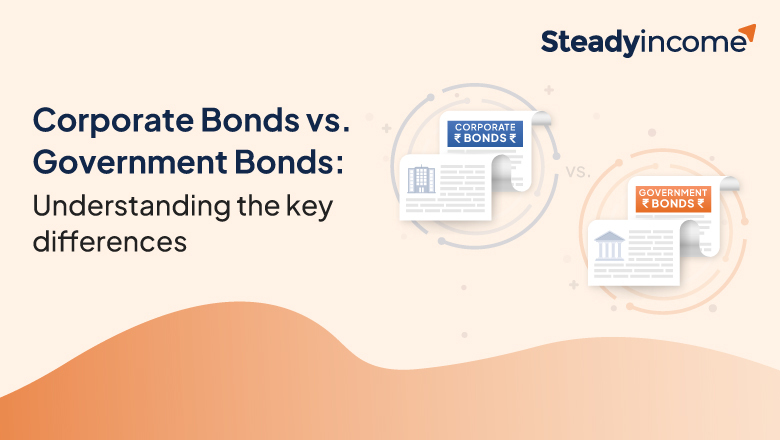Corporate Bonds vs. Government Bonds: Understanding the Key Differences

When it comes to fixed-income investments, two major players stand out: corporate bonds and government bonds. Both offer a way to earn stable returns, but they come with distinct characteristics that influence their risk, return, and role in a portfolio. Understanding the differences between these bond investments can help investors make more informed decisions that align with their financial goals.
What Are Corporate Bonds?
Corporate bonds are financial instruments that companies use to borrow funds from investors, typically used to finance business operations or growth. When an investor buys a corporate bond, they essentially lend money to the company in exchange for regular interest payments (also known as coupon payments) and the return of the principal at maturity.
These bonds come in different varieties, including:
- Investment-grade bonds: Issued by financially stable companies with lower risk and lower returns.
- High-yield (or junk) bonds: Issued by companies with higher risk but offering higher returns.
Corporate bonds are typically rated by agencies like Moody’s or Standard & Poor’s to indicate the creditworthiness of the issuer. Higher-rated bonds are considered safer but may offer lower yields, while lower-rated bonds provide higher potential returns but come with increased risk.
What Are Government Bonds?
Government bonds, on the other hand, are debt securities issued by a country’s government to fund its activities. In India, these include treasury bills, government securities (G-Secs), and sovereign gold bonds, among others. The main advantage of government bonds is their safety. Because they are backed by the government, they have a much lower risk of default compared to corporate bonds.
Like corporate bonds, government bonds also pay regular interest, and the principal is returned at maturity. However, the yield on government bonds is generally lower, reflecting the lower risk associated with them.
Key Differences Between Corporate and Government Bonds
1. Risk Level
- Corporate bonds: The risk is higher because companies can default on their debt if they face financial difficulties. High-yield bonds, in particular, carry significant default risk.
- Government bonds: These are considered much safer as they are backed by the government. The risk of default is minimal, especially for developed countries with strong economies.
2. Returns
- Corporate bonds: Tend to offer higher yields to compensate for the greater risk. Investors in high-yield bonds can enjoy substantial returns but must be willing to accept potential losses.
- Government bonds: Offer lower yields in exchange for the safety they provide. They are typically chosen by conservative investors looking for stable income with minimal risk.
3. Credit Rating
- Corporate bonds: Credit rating agencies assess the creditworthiness of companies, influencing the bond's yield. Lower-rated companies must offer higher returns to attract investors.
- Government bonds: Usually have high credit ratings, especially those issued by stable governments like India, the US, and the UK, meaning they come with a lower interest rate.
4. Market Liquidity
- Corporate bonds: Generally less liquid than government bonds, especially if they are issued by smaller companies or are lower-rated.
- Government bonds: Highly liquid and widely traded in the market, making them easier to buy and sell.
5. Purpose of Issuance
- Corporate bonds: Issued to fund business expansions, acquisitions, or day-to-day operations.
- Government bonds: Issued to fund public projects, infrastructure, and other national interests.
6. Tax Implications
- Corporate bonds: Interest income is taxable, and the tax rates vary depending on the country’s tax laws.
- Government bonds: In many countries, government bonds may come with tax advantages. For example, some Indian government bonds offer tax-free interest income.
Corporate Bonds vs. Government Bonds: Which is better for Your Portfolio?
Choosing between corporate bonds and government bonds depends on your investment goals, risk tolerance, and time horizon.
- If you are a conservative investor who prioritizes safety and stability, government bonds are likely a better fit.
- On the other hand, if you're willing to take on more risk for higher potential returns, corporate bonds, particularly high-yield bonds, may be worth considering.
Many investors also choose to include both types of bonds in their portfolios to balance risk and return. Corporate bonds can provide higher income, while government bonds offer security and a safety net during uncertain times.
Conclusion
In the world of fixed-income investments, both corporate and government bonds play critical roles. Corporate bonds offer higher returns but come with higher risk, while government bonds provide security with lower yields. Understanding these differences allows investors to build a more balanced and diversified portfolio that meets their personal financial needs and objectives. Whether you seek high returns or safety, aligning your bond investment with your goals will help you make the most out of your fixed-income strategy.


